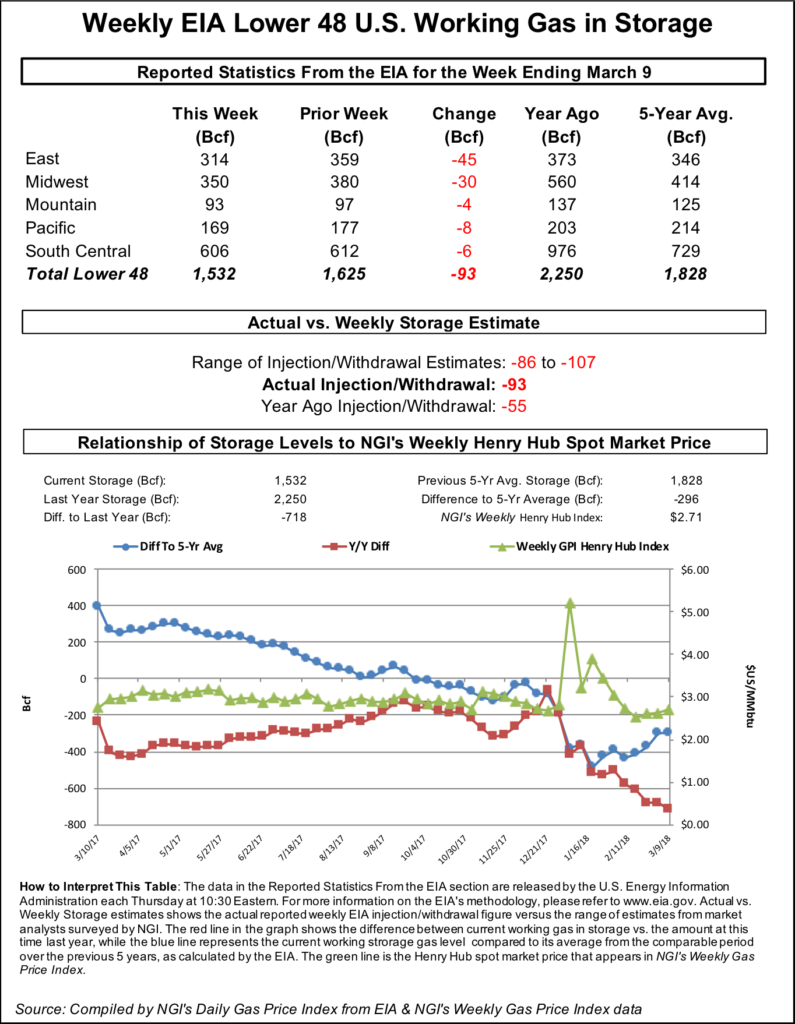Markets | NGI All News Access | NGI Data
Natural Gas Futures Drop as EIA Storage Stats a Slightly Bearish Miss
The Energy Information Administration (EIA) on Thursday reported a weekly storage withdrawal that missed to the bearish side of market expectations, and futures sold off a few cents on the news.

EIA reported a 93 Bcf withdrawal from U.S. gas stocks for the week ending March 9, tighter than the 55 Bcf withdrawn a year ago and close to the five-year average withdrawal of 97 Bcf. Last week, EIA reported a 57 Bcf withdrawal for the week ending March 2.
As the figure crossed trading desks at 10:30 a.m. EDT, the April contract promptly sold off around 3 cents, slipping from $2.730 to around $2.695-2.700. By 11 a.m. EDT, April was trading around $2.685, down about 4.5 cents from Wednesday’s settle.
Prior to Thursday’s report, the market had been looking for a withdrawal slightly tighter than the actual number.
A Reuters survey of traders and analysts had on average predicted a 96 Bcf withdrawal, with responses ranging from -86 Bcf to -107 Bcf. OPIS analysts had predicted a 96 Bcf withdrawal, citing higher demand from the recent winter weather in the Northeast. Stephen Smith Energy Associates had forecast a 99 Bcf draw, while Kyle Cooper of IAF Advisors had called for a 101 Bcf withdrawal.
Intercontinental Exchange EIA storage futures settled at -100 Bcf Wednesday for this week’s report.
“This is back-to-back weeks where the EIA print was 5 Bcf below our expectations, indicating the market is not quite as tight as expected,” Bespoke Weather Services said shortly after the release of the EIA data. “That said, we had been slightly on the lower end of expectations with today’s withdrawal as we did not see weather last week as particularly impressive.
“Even with today’s miss the market remains tight enough for us to not see all that much downside opened up,” the firm said. “We will watch for $2.68 to hold and prices to recover if afternoon model guidance holds, though it will be difficult for prices to work back up much with this slight miss.”
Total working gas in underground storage in the Lower 48 ended the week at 1,532 Bcf, versus 2,250 Bcf a year ago and five-year average inventories of 1,828 Bcf. The year-on-year storage deficit increased week/week from -680 Bcf to -718 Bcf, while the year-on-five-year deficit narrowed slightly from -300 Bcf to -296 Bcf, EIA data show.
By region, the largest withdrawal came in the East region at 45 Bcf, while 30 Bcf was pulled in the Midwest. The South Central region saw a 6 Bcf withdrawal for the week, 3 Bcf from salt and 3 Bcf from nonsalt. In the Pacific, 8 Bcf was withdrawn, while 4 Bcf was withdrawn in the Mountain region, according to EIA.
© 2024 Natural Gas Intelligence. All rights reserved.
ISSN © 1532-1231 | ISSN © 2577-9877 |
